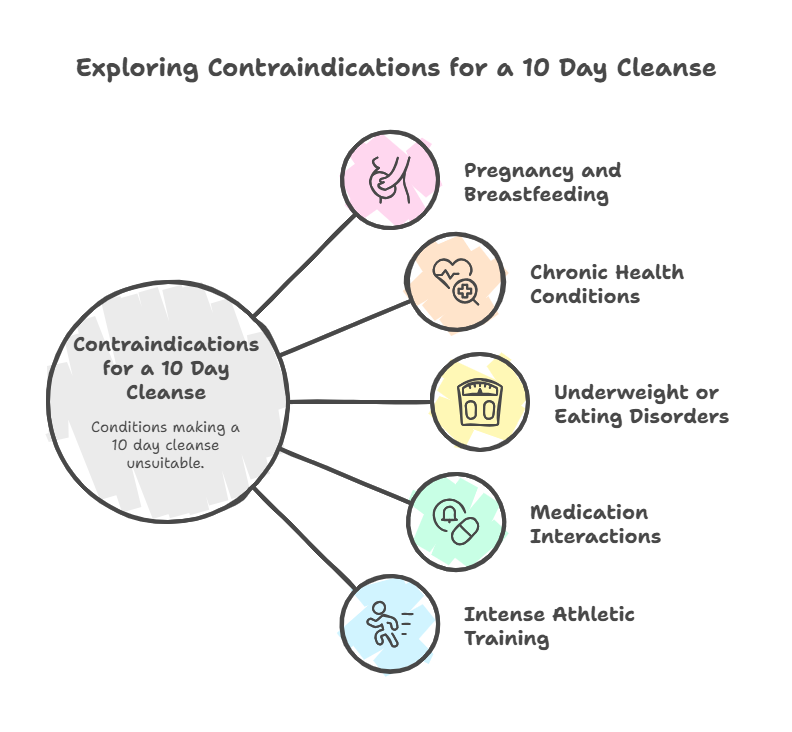Thinking about a 10 day cleanse? You’re not alone! Many people choose this method to reset their health. They see a 10-day detox program as a way to refresh their bodies and start new habits. But before you dive in, it’s important to know what a 10 day cleanse entails and if it fits your health goals.
“The best cleanse isn’t a quick fix—it’s a shift toward sustainable habits that support your liver, gut, and overall health every day.”
Dr. Mark Hyman
A 10 day cleanse, also known as a reset, usually involves a specific diet or certain products. The main aim is to remove toxins from the body and improve gut health. Let’s look at what a 10-day detox involves and what you should consider before starting a detox plan.
What Is a 10 Day Cleanse?
A 10 day cleanse is a short diet plan that helps the body detox. These programs, often called a day detox, differ widely in their methods. The main goal is to cut back on processed foods and irritants. This gives your digestive system a break and may help with built-up toxins.
Detox programs come in various forms. Some emphasize specific drinks, while others change solid food intake. Knowing the different types can help you decide which one fits your needs.
Some common types of 10 day cleanse or detox program structures include:
- Juice Cleanses: Consuming only fruit and vegetable juices.
- Smoothie Cleanses: Replacing meals with nutrient-dense smoothies, often including ingredients like almond milk.
- Raw Food Diets: Eating only uncooked fruits, vegetables, nuts, and seeds.
- Elimination Diets: Removing common allergens or irritants like gluten, dairy, soy, and sugar to identify food sensitivities.
- Supplement-Based Cleanses: Using specific pills, powders, or drinks alongside a restricted diet, sometimes containing ingredients like milk thistle or magnesium citrate.
Each specific day plan or detox protocol has its own detailed rules and guidelines regarding acceptable foods and practices. Thorough research is necessary before starting any day detox program. It’s also wise to review the ingredients of any supplements, noting potential fillers like microcrystalline cellulose, gum acacia, or guar gum, along with active components like ascorbic acid or pantothenic acid.
The Potential Benefits of a 10 Day Cleanse
Advocates suggest that participating in a 10 day cleanse offers numerous health benefits. While scientific evidence supporting drastic short-term cleanses is limited compared to long-term healthy eating, some people report positive experiences. Potential perceived advantages might include several areas of well-being.
Weight Loss
Many individuals use a cleanse hoping to lose weight quickly. A temporary reduction in calorie intake and potential water loss can lead to a lower number on the scale during the 10 day cleanse. However, this initial weight loss is often not sustainable fat loss and may return once regular eating patterns resume.
Improved Digestion
Temporarily removing processed foods, heavy meals, and potential irritants might reduce symptoms like bloating and discomfort for some. This dietary shift during the detox phase can give the digestive system a break. Enhanced gut health and improved digestion are frequently reported anecdotal benefits.
Increased Energy
Some participants feel higher energy levels during or after completing a detox plan. This could result from cutting out refined sugars and processed foods common in the Standard American Diet. An increased intake of nutrient-dense foods like fruits and vegetables might also contribute to feeling more vibrant.
Mental Clarity
Experiencing reduced brain fog and improved focus is another benefit sometimes linked to cleanses. This might be connected to stabilizing blood sugar levels by removing refined carbohydrates1. The psychological effect of actively pursuing health goals can also contribute to a sense of mental sharpness and help improve mood.
Clearer Skin
Some individuals notice improvements in their skin complexion during a cleanse. Reducing processed foods, increasing hydration, and boosting nutrient intake might contribute to clearer skin. However, results vary greatly among individuals.
Potential Risks and Side Effects
Despite potential upsides, 10 day cleanses are not without risks and potential side effects. It’s essential to weigh these factors carefully before starting such a restrictive eating pattern. Understanding the downsides can help you make an informed decision about this type of detox program.
Nutrient Deficiencies
Highly restrictive cleanses, especially those eliminating entire food groups (like certain proteins or healthy fats), can lead to inadequate intake of essential vitamins and minerals. This risk increases if the cleanse is not well-formulated or is followed for too long. Deficiencies in folic acid or pyridoxine HCl (Vitamin B6) could occur depending on the specific restrictions.
Dehydration
Certain detox protocols might encourage practices or include supplements with diuretic or laxative effects. This can lead to excessive fluid loss and dehydration2. Symptoms include headaches, dizziness, fatigue, and constipation, undermining the cleanse’s goals.
Electrolyte Imbalances
Sudden, drastic changes in food and fluid intake can disrupt the delicate balance of electrolytes (like sodium, potassium, and magnesium) in your body3. This imbalance can cause issues such as muscle cramps, weakness, and potentially serious heart rhythm disturbances. Using supplements like magnesium citrate should be done cautiously.
Blood Sugar Fluctuations
Cleanses relying heavily on fruit juices can cause sharp increases followed by rapid drops in blood sugar levels. This volatility is particularly concerning for individuals with diabetes, insulin resistance, or hypoglycemia4. Maintaining stable sugar levels is crucial for metabolic health.
Other Considerations
Other potential side effects include fatigue, headaches (especially from caffeine withdrawal), irritability, persistent sugar cravings, and digestive upset. Drastic calorie restriction can sometimes lead to muscle loss rather than fat loss. Some individuals may also experience temporary joint pain as their body adjusts.
Is a 10 Day Cleanse Right for You?
Deciding whether to undertake a 10 day cleanse requires careful consideration of your individual health status, lifestyle, and health goals. These short-term detox programs are not universally suitable or safe. It’s critical to evaluate your personal circumstances before starting.
A 10 day detox program may not be appropriate if you:

- Are pregnant or breastfeeding.
- Have a chronic health condition, such as diabetes, kidney disease, or heart problems.
- Are underweight or have a history of eating disorders.
- Are taking specific medications that could interact with the cleanse components or be affected by dietary changes.
- Are an athlete undergoing intense training.
Consulting with a knowledgeable healthcare practitioner or a registered dietitian before beginning any day detox program is highly recommended. They can assess your health, discuss potential risks, and help determine if a cleanse aligns with your overall health care plan. They can also guide you towards safer, more sustainable approaches if a cleanse isn’t suitable.
Alternatives to a 10 Day Cleanse
If your goal is to improve your health, a strict 10 day cleanse might feel too extreme. Luckily, there are many effective and sustainable alternatives. These options help you build healthy habits for the long run. Try adding these strategies to your routine:
Balanced, Whole Foods Diet
Choose a diet full of unprocessed, nutrient-rich foods. Eat clean by adding lots of fruits, veggies, lean proteins, whole grains, and healthy fats. This approach gives you lasting energy and helps your body detox naturally5. It also shifts you away from the usual American diet without severe limits.
Increase Fiber Intake
Getting enough fiber is key for digestive health. It helps keep things regular and supports the body’s natural way of getting rid of waste. Good sources include fruits, vegetables, legumes, nuts, seeds, and whole grains. Gradually increasing fiber can prevent digestive discomfort.
Intermittent Fasting
Various intermittent fasting schedules involve cycling between periods of eating and voluntary fasting. Some research suggests potential benefits for metabolic health and cellular repair processes. Common methods are the 16/8 method and occasional 24-hour fasts. They provide structure without strict food limits.
Adequate Hydration
Drinking enough water is key for almost all body functions. This includes the natural detox process done by the kidneys and liver. Aim to stay hydrated throughout the day. Many people start their day with lemon water. Cutting back on sugary drinks is also helpful.
Regular Physical Activity
Regular exercise helps circulation and promotes sweating. It also supports the lymphatic system, which aids the body in managing waste. Aim for a mix of cardiovascular, strength, and flexibility exercises most days of the week. This also helps improve mood.
Mindful Eating & Stress Management
Mindful eating helps you notice hunger and fullness signals. This can cut down on overeating and boost digestion. Managing stress is key too. Techniques like meditation and yoga can help. Chronic stress harms digestion and overall health.
How to Safely Complete a 10 Day Cleanse
Talk to a healthcare provider before starting a 10 day cleanse. Your safety is important. A well-managed detox journey involves planning and listening to your body. Always follow instructions provided by the specific detox protocol you choose.
Choose a Sensible Program
Choose a day plan that focuses on whole foods. Include fruits, vegetables, and lean proteins. Don’t rely only on juices or powders. Make sure the plan offers enough calories and nutrients for your body. Steer clear of programs with unrealistic claims or harmful practices.
The Preparation Phase
Don’t jump into a strict cleanse right away, especially if you eat a typical American diet. First, prepare for several days. Gradually cut back or remove caffeine, alcohol, refined sugars, and processed foods. This helps reduce withdrawal symptoms like headaches and strong sugar cravings.Stay Hydrated
Stay Hydrated
Maintaining hydration is critical during any detox phase. Drink ample water, herbal teas, or other approved fluids specified in your day detox plan. Staying hydrated helps your kidneys work well. It flushes out toxins and can ease fatigue and other side effects.
Listen to Your Body
Pay close attention to your body’s signals throughout the 10 day cleanse. Mild fatigue or headaches might occur initially. Stop the cleanse if you have severe symptoms. These include dizziness, extreme weakness, fainting, or ongoing pain. Then, talk to your healthcare practitioner.
The Reintroduction Phase
Transitioning back to regular eating after the 10-day cleanse is a critical phase known as reintroduction. During this time, it’s important to gradually reintroduce foods over several days to allow your digestive system to adjust. Start with gentle, easy-to-digest options such as steamed vegetables, fresh fruits, and nourishing soups. Then, slowly reintroduce other food groups, one at a time.
This mindful approach not only prevents overwhelming your system but also helps identify any potential food sensitivities. For additional support with detoxification and managing potential toxin exposure during this transition, you may want to explore our guide on heavy metal detoxification.
Understanding the Detoxification Process
Your body has built-in systems for detoxification. The liver, kidneys, lungs, skin, and digestive tract filter out waste and foreign substances. They work hard to keep the body clean. Keeping these organs healthy through a good lifestyle is the best long-term approach.
A short 10-day detox program might help you reset mentally or change bad eating habits. However, it usually doesn’t detoxify the body as advertised. Extreme diets for flushing out toxins don’t have solid scientific backing. Instead, focus on boosting your body’s natural detox processes with consistent healthy habits.
Some commercial detox products include ingredients like milk thistle for liver support. They may also have ascorbic acid (Vitamin C) and B vitamins. These include pantothenic acid and pyridoxine HCl.
However, their efficacy in the context of a short 10 day cleanse is often debated. Always research ingredients and consult your healthcare provider before using supplements.
Long-Term Health and Wellness
A 10 day cleanse can give a short-term boost, but it isn’t a substitute for long-term health. Real well-being comes from making positive lifestyle choices consistently, not from quick fixes. True health improvements arise from habits that support your body daily.
For lasting results and better metabolic health, focus on these ongoing habits:
- Eat a healthy diet. Pick real foods such as fruits, veggies, lean proteins, whole grains, and healthy fats. Cut down on processed foods, sugary drinks, and excess saturated fats.
- Stay hydrated. Drink plenty of water every day. This helps your body work well and supports natural detox.
- Exercise regularly. Try to get 150 minutes of moderate aerobic activity or 75 minutes of vigorous activity each week. Include muscle-strengthening exercises too.
- Get enough sleep: Aim for 7-9 hours of quality sleep every night. Sleep is vital for your body’s repair and regulation.
- Manage stress: Try techniques like meditation, deep breathing, or yoga. Spend time in nature to lower stress each day.
This approach helps your body work at its best every day.atterns and lifestyle choices consistently offers far greater benefits for gut health, energy levels, and overall vitality than any temporary cleanse. This approach helps your body’s natural systems function optimally every day.
Conclusion
A 10 day cleanse may seem like a good way to start healthier habits or lose weight quickly. However, it’s important to have realistic expectations and be aware of potential risks. Some people say they feel better digestion and less brain fog after a 10 day cleanse. However, health experts question how effective these severe cleanses are over time.
Before starting any 10-day detox program, research the specific plan carefully. Consider your health and speak with a trusted healthcare provider or dietitian. Keep in mind that these cleanses don’t treat any underlying health issues. To achieve lasting health and energy, focus on a balanced diet. Eat clean foods, exercise regularly, and stay hydrated. Also, make healthy lifestyle choices. This approach works best over time.
Small Step, Big Impact
Embarking on a 10-day cleanse can rejuvenate your body and mind. Start by eliminating processed foods, staying hydrated, and incorporating daily physical activity. Remember, consistency is key to experiencing the full benefits.
Listen to this article
This is an AI generated Podcast version of the article.
- https://hms.harvard.edu/news-events/publications-archive/brain/sugar-brain[↩]
- https://www.nccih.nih.gov/health/detoxes-and-cleanses-what-you-need-to-know[↩]
- https://my.clevelandclinic.org/health/symptoms/24019-electrolyte-imbalance[↩]
- https://www.medicalnewstoday.com/articles/323310[↩]
- https://nutritionsource.hsph.harvard.edu/clean-eating/[↩]



